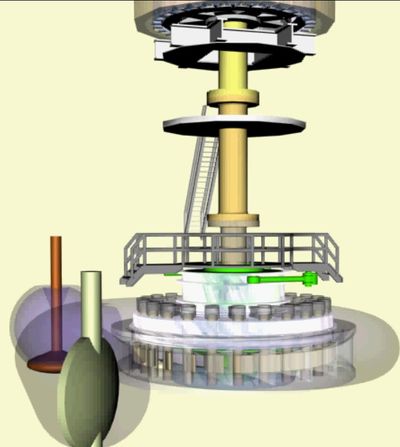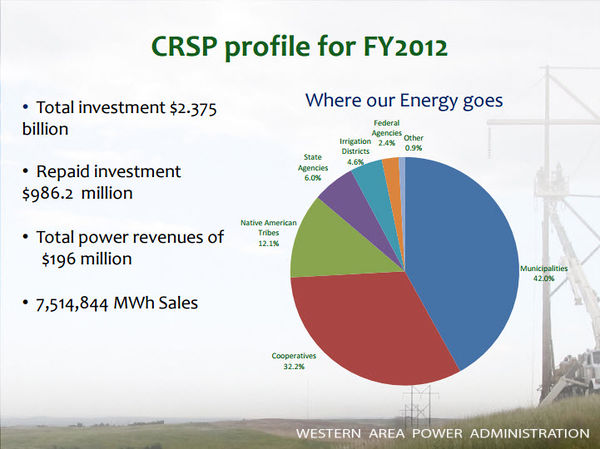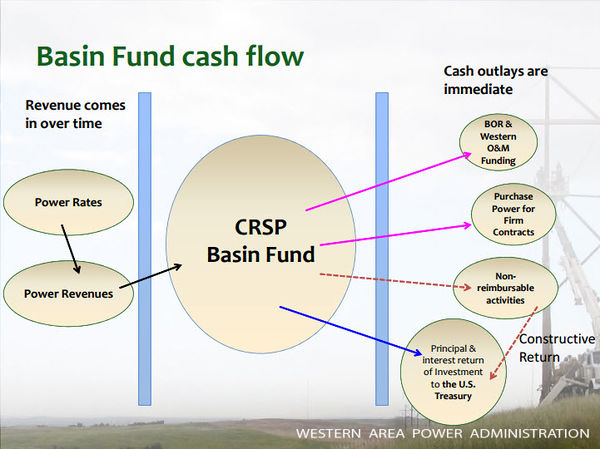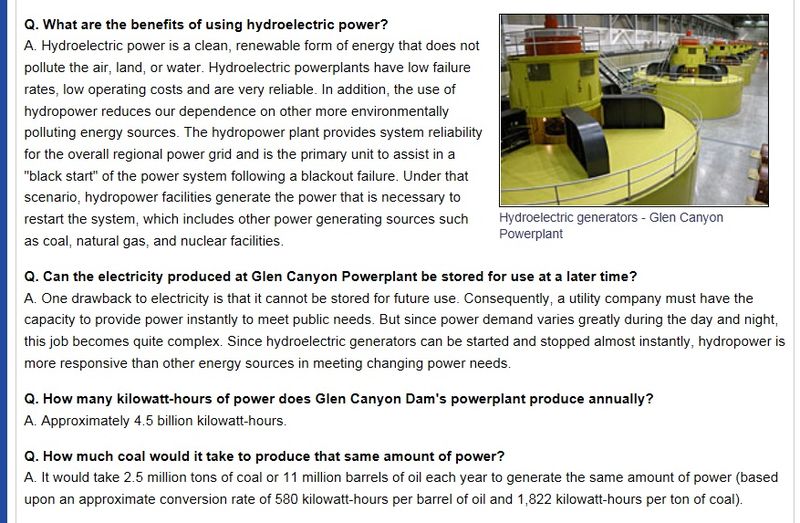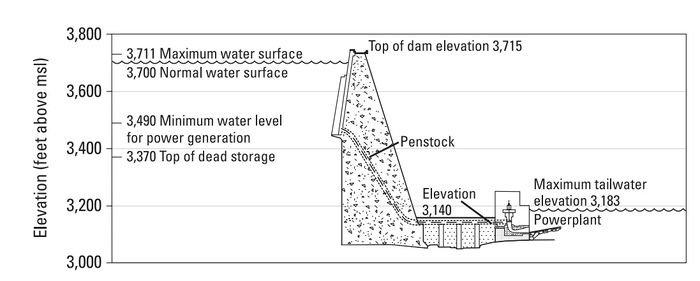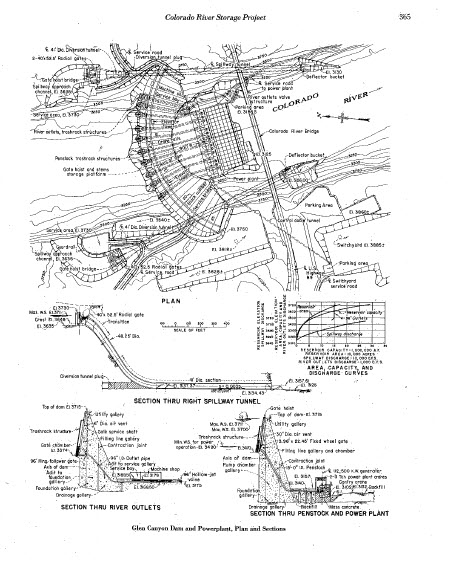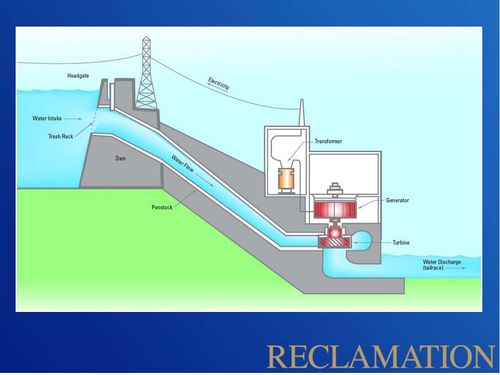Difference between revisions of "HYDROPOWER"
Cellsworth (Talk | contribs) |
Cellsworth (Talk | contribs) |
||
| Line 35: | Line 35: | ||
The designation of Glen Canyon National Recreation Area in 1972, underscores the value and importance of the recreation benefits associated with Lake Powell and the Colorado River downstream of the dam. The GCNRA is managed by the National Park Service. | The designation of Glen Canyon National Recreation Area in 1972, underscores the value and importance of the recreation benefits associated with Lake Powell and the Colorado River downstream of the dam. The GCNRA is managed by the National Park Service. | ||
| − | Glen Canyon Dam is the key water storage unit of the Colorado River Storage Project, one of the most complex and extensive river resource developments in the world. Without it, development of the Upper Colorado River Basin states’ portion of the Colorado River would not have been possible. | + | Glen Canyon Dam is the key water storage unit of the Colorado River Storage Project, one of the most complex and extensive river resource developments in the world. Without it, development of the Upper Colorado River Basin states’ portion of the Colorado River would not have been possible. [http://www.usbr.gov/uc/rm/crsp/gc/] |
==[[Portal:Desired Future Conditions -DFCs| '''Desired Future Condition for the Hydropower Resource''']]== | ==[[Portal:Desired Future Conditions -DFCs| '''Desired Future Condition for the Hydropower Resource''']]== | ||
| Line 43: | Line 43: | ||
• Maintain the operational flexibility (including but not limited to load following capability, ramp rates, and emergency operations allowances) that enable Reclamation and WAPA to meet the system operating and other regulatory requirements of WECC, North American Electric Reliability Corporation and the Federal Energy Regulatory Commission, as well as emergency operating criteria for safety and human health situations.<br> | • Maintain the operational flexibility (including but not limited to load following capability, ramp rates, and emergency operations allowances) that enable Reclamation and WAPA to meet the system operating and other regulatory requirements of WECC, North American Electric Reliability Corporation and the Federal Energy Regulatory Commission, as well as emergency operating criteria for safety and human health situations.<br> | ||
• Maximize the environmental benefits of hydropower generation at Glen Canyon Dam.<br> | • Maximize the environmental benefits of hydropower generation at Glen Canyon Dam.<br> | ||
| − | • Minimize carbon emissions through hydropower generation at Glen Canyon Dam. | + | • Minimize carbon emissions through hydropower generation at Glen Canyon Dam. [http://gcdamp.com/index.php?title=Portal:Desired_Future_Conditions_-DFCs] |
|}<!-- | |}<!-- | ||
| Line 61: | Line 61: | ||
|style="color:#000;"| | |style="color:#000;"| | ||
| − | [[File:BenefitsCRSP.jpg |600px]] | + | [[File:BenefitsCRSP.jpg|center|600px]] |
| − | [[File:CRSPprofile.jpg |600px]] | + | [[File:CRSPprofile.jpg|center|600px]] |
| − | [[File:EnvironmentalFunds.jpg |600px]] | + | [[File:EnvironmentalFunds.jpg|center|600px]] |
| − | [[File:BasinFund.jpg |600px]] | + | [[File:BasinFund.jpg|center|600px]] |
[[File:USBR- Q& A on GCD Hydropower.jpg|800px|lect|USBR- Q& A on GCD Hydropower]] | [[File:USBR- Q& A on GCD Hydropower.jpg|800px|lect|USBR- Q& A on GCD Hydropower]] | ||
| Line 84: | Line 84: | ||
|- | |- | ||
|style="color:#000;"| | |style="color:#000;"| | ||
| − | *[http://www. | + | *[http://www.usbr.gov/uc/rm/crsp/gc/index.html U.S. Bureau of Reclamation (USBR)] |
| − | + | *[https://www.wapa.gov/Pages/western.aspx Western Area Power Administration (WAPA)] | |
| − | *[ | + | *[http://www.creda.org/ Colorado River Energy Distribution Association (CREDA)] |
| − | *[ | + | |
*[[GCDAMP- GTMAX| GTMax Page]] | *[[GCDAMP- GTMAX| GTMax Page]] | ||
| Line 108: | Line 107: | ||
|- | |- | ||
| − | ! <h2 style="margin:0; background:#cedff2; font-size:120%; font-weight:bold; border:1px solid #a3b0bf; text-align:left; color:#000; padding:0.2em 0.4em;"> | + | ! <h2 style="margin:0; background:#cedff2; font-size:120%; font-weight:bold; border:1px solid #a3b0bf; text-align:left; color:#000; padding:0.2em 0.4em;"> [https://www.wapa.gov/About/the-source/Pages/annual-reports.aspx WAPA Annual Reports] </h2> |
|- | |- | ||
|style="color:#000;"| | |style="color:#000;"| | ||
| − | *[ | + | *[https://www.wapa.gov/newsroom/Publications/Documents/FY-2016-annual-report.pdf FY16 Annual Report] |
| − | *[https://www.wapa.gov/Pages/ | + | *[https://www.wapa.gov/newsroom/Publications/Documents/FY-2015-annual-report.pdf FY15 Annual Report] |
| − | *[ | + | *[https://www.wapa.gov/About/Pages/results-of-operation.aspx FY15 Results of Operations] |
| + | *[https://www.wapa.gov/newsroom/Publications/Documents/FY-2015-statistical-appendix.pdf FY15 Statistical Appendix] | ||
| + | *[https://www.wapa.gov/newsroom/Publications/Documents/2014AR.pdf FY14 Annual Report] | ||
| + | *[https://www.wapa.gov/newsroom/Documents/AR-2013.pdf FY13 Annual Report] | ||
| + | *[https://www.wapa.gov/newsroom/Documents/annrep12.pdf FY12 Annual Report] | ||
|- | |- | ||
| Line 126: | Line 129: | ||
[[File:Water Intake Diagram.jpg|500px]] | [[File:Water Intake Diagram.jpg|500px]] | ||
| + | *[http://www.creda.org/Documents/Messaging%20Final%20100510.pdf CREDA Fact Sheet on Hydropower and Glen Canyon Dam] | ||
| + | *[[Media:Jeka PPT Capacity Energy handout 2013.pdf| Capacity & Energy handout]] | ||
| + | *[[Media:140403 JRaub-SRP Explaination on why Capacity is important.pdf | Explanation on Why Capacity is Important]] | ||
| + | *[[Media:Messaging 2.pdf |Importance of Hydropower Capacity]] | ||
<br> | <br> | ||
|} | |} | ||
Revision as of 13:51, 8 February 2017
|
|
The Hydropower ResourceGlen Canyon Dam is the second highest (710 feet) concrete-arch dam in the United States, second only to Hoover Dam which stands at 726 feet. The 26.2 million acre-feet of water storage capacity in Lake Powell, created by Glen Canyon Dam, serves as a ‘bank account’ of water that is drawn on in times of drought. This stored water has made it possible to successfully weather extended dry periods by sustaining the needs of cities, industries, and agriculture throughout the West. Hydroelectric power produced by the dam’s eight generators helps meet the electrical needs of the West’s rapidly growing population. With a total capacity of 1,320 megawatts, Glen Canyon Powerplant produces around five billion kilowatt-hours of hydroelectric power annually which is distributed by the Western Area Power Administration to Wyoming, Utah, Colorado, New Mexico, Arizona, Nevada, and Nebraska. In addition, revenues from production of hydropower help fund many important environmental programs associated with Glen and Grand canyons. The designation of Glen Canyon National Recreation Area in 1972, underscores the value and importance of the recreation benefits associated with Lake Powell and the Colorado River downstream of the dam. The GCNRA is managed by the National Park Service. Glen Canyon Dam is the key water storage unit of the Colorado River Storage Project, one of the most complex and extensive river resource developments in the world. Without it, development of the Upper Colorado River Basin states’ portion of the Colorado River would not have been possible. [1] Desired Future Condition for the Hydropower Resource• Glen Canyon Dam capacity and energy generation is maintained and increased, so as to produce the greatest practicable amount of power and energy, consistent with the other DFCs. |
| --- |
Hydropower - Online Training |
--- |
|---|
|
|
